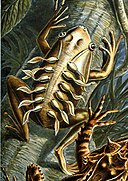Tập tin:Haeckel frogs with labels.jpg

Kích thước hình xem trước: 435×599 điểm ảnh. Độ phân giải khác: 174×240 điểm ảnh | 349×480 điểm ảnh | 558×768 điểm ảnh | 744×1.024 điểm ảnh | 2.520×3.468 điểm ảnh.
Tập tin gốc (2.520×3.468 điểm ảnh, kích thước tập tin: 2,66 MB, kiểu MIME: image/jpeg)
Lịch sử tập tin
Nhấn vào ngày/giờ để xem nội dung tập tin tại thời điểm đó.
| Ngày/giờ | Hình xem trước | Kích cỡ | Thành viên | Miêu tả | |
|---|---|---|---|---|---|
| hiện tại | 04:48, ngày 13 tháng 2 năm 2006 |  | 2.520×3.468 (2,66 MB) | Ragesoss | From 1904 book by Haeckel |
Trang sử dụng tập tin
Có 4 trang tại Wikipedia tiếng Việt có liên kết đến tập tin (không hiển thị trang ở các dự án khác):
Sử dụng tập tin toàn cục
Những wiki sau đang sử dụng tập tin này:
- Trang sử dụng tại bg.wikipedia.org
- Trang sử dụng tại ceb.wikipedia.org
- Trang sử dụng tại pl.wikipedia.org





